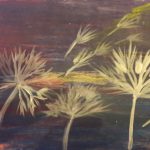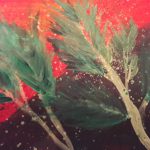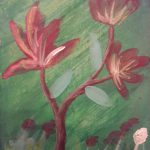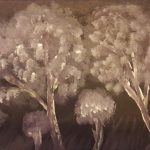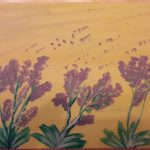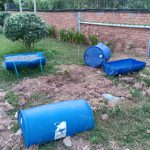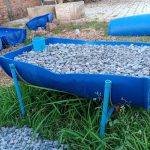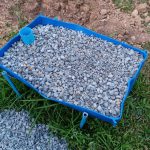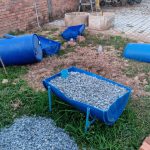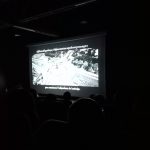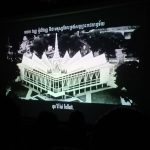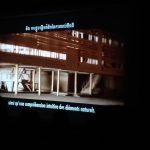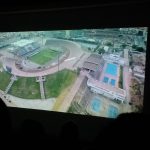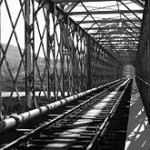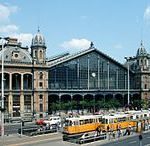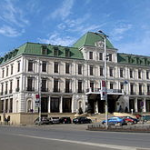I have spent most of the holiday painting and drawing when I have free time I would take a brush and started to paint. For most, I would like to tell you that I decide to get thick wood then sand it out. So the surface would be smooth for painting. I have my own challenge to paint a painter for the teacher as a gift to say thank you for the amazing year.
Sustainable Farming — Aquaponic
This year I’ve been involved in an Aquaponic one-year project — relates to any system that mixes standard aquaculture with hydroponics in a symbiotic setting. We are thinking of constructing our own system inside our school. We’re doing little by little, first off, we’ve been doing system research. After a long period of research, we have done some more research on the material we have in Cambodia, which is affordable to the local if they want to recreate the design we have. So we found the material we’d like to find. We did a few designs after research that fit with material and easy to replicate in the future as well. The design we have, however, The design we keep changing the construction phase. We finally collected all the material and started building the system. So below is the building stage’s progress. Enjoy:)
The Man who built Cambodia _ Vann Moyvann story
The story of Vann Molyvann, an iconic architect whose legacy could shape a new vision for Cambodia.
Vann Molyvann is a Cambodia architect that shape and creates a monumental monument — National Sports Complex, Chaktomuk Conference Hall, Independence Monument. He legacy has been diminished little by little due to the cultural vandalism by those who allowed the demolition/destruction of some of his finer buildings. I was miserable when I saw what had happened to Cambodia and the structure that was built. Vann Molyvann is my star that I look up to all the time. He was my inspiration to create the structure for future Cambodia.
Poem___ Being Happy
A poetry book had been released by junior learners in the Khmer literacy school Liger. All the masterpieces (all the poems) were made by students of Liger seniors. One poem I wrote about being happy.
It’s unlike any other job we all did during the day to be happy every day. It’s a job we don’t have to tell anyone to do. Also, I’m a person who likes to be happy about the topic.
សើចដោយសប្បាយ
សើចសុខសប្បាយ រីករាយស្រស់ស្រាយ វង់ភ័ក្ដ្រភ្លឺថ្លា
សើចសមបានច្រើន ចម្រើនវាចា សើចតាមតម្រា
សុខភាពមាំមួន។
សើចបានមង្គល សើចដូចជ្រូកពុល លើកសម្រស់ខ្លួន
សើចតាមកម្រត់ ភត្រាមាសសួន សើចមិនលាក់ពួន
ដួងចិត្តជ្រះថ្លា។
សើចមុខមិត្តជិត សប្បាយពេកពិត មិត្តភក្ដិញាតិសា
សើចប្រាណរឹងពឹង សើចពេលធ្វើការ ចេះថែរក្សា
ទ្រព្យនឹងគង់វង្ស។
សើចបំពេញការ សើចចារមាត្រា សើចថែទ្រព្យគង់
សើចចាកក្ដីទុក កុសលទ្រទ្រង់ សើចឆ្លាតមិនល្ងង់
សើចមានមង្គល។
Graphing Polynomials
Another Fun round of Math!
I know math is not the fun class but I am really enjoying study the subject this year, within 2018 – 2019 I got to learn about Precalculus, which includes algebra and trigonometry at a level which is designed to prepare students for the study of calculus. Ever thought, algebra and trigonometry is not my strength I still want to build those skill into my strength. This round we are studying in Chapter 3 (Polynomial and Rational Functions), which include seven smaller subjects. I would like to show some example in the small subjects that related to Chapter 3.
In Chapter 3.2 (Polynomial Functions and Their Graphs) we learn the polynomial functions simply as polynomials. The following polynomial has degree 5 leading coefficient 3, and constant term -6

We also need to understand how the graph of a basic polynomial function look like and which graph is not a polynomial function.
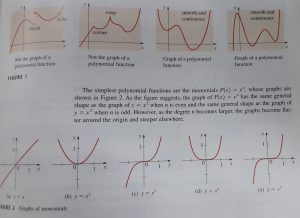
Example: P(x)=x^4 − x^3 − 6x^2
First, we’ll need to factor this polynomial as much as possible so we can identify the zeros and get their multiplicities.
P(x )= x^4 − x^3 − 6x^2 = x^2(x^2 − x − 6) = x^2(x − 3)(x + 2)
Here is a list of the zeroes and their multiplicities.
X = −2 (multiplicity 1)
X = 0 (multiplicity 2)
X = 3 (multiplicity 1)
So, the zeros at x = -2 and x = 3 which will correspond to x-intercepts, that cross the x-axis since their multiplicity is odd. The zero at x = 0 will not cross the x-axis since it multicity is even. The y-intercept is (0,0) and notices that this is also an x-intercept.
The coefficient of the 4th-degree term is positive and so since the degree is even we know that the polynomial will have a positive infinite bound at both ends of the graph.
Finally, here are some function that helps to the graph, We need to plug in a random number to help identify the behavior of the graph. Normally, we would have one point in between the zeros.
P(−3) = 54
P(−1) = −4
P(1) = −6
P(4) = 96
Here is a sketch of a graph
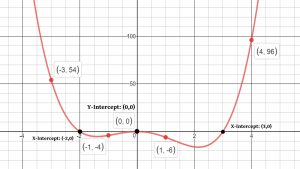
S’more Stoichiometry Lab
FUN! FUN! Another day for Lab! FOOD!
You’ve ever cooked a meal from a recipe, you will have noticed they come with serving amounts, in fact, this number can be off, and you’ll end up with either less or more food than you anticipated. A number of things can take an account for this difference – food spillage prior to cooking, leaving ingredients too long on the stove top, using the wrong measuring cup, and so forth.
The similar can happen at whatever point we have an experiment in the chemistry lab to make a compound. We first make a calculation for how much of a compound we’ll end up with, in fact, these calculation are made under ideal conditions. They don’t account for experimental errors or personal errors of the experimenter. In the end, your prediction is often different from what you have actually made.
In Chemistry, we have learned about theoretical yield, which is the amount of the product calculated from the limiting reactant. The limiting reactant is the reactant in the chemical reaction that limits the amount of product that it can produce. The actual yield is the actual amount of the product, which the experiment produces.
The difference between theoretical yield and actual yield can be calculated by using percent yield, which we can use this formula:
In order to use this formula, the theoretical yield and actual yield need to have the same unit. If the actual yield in gram, the theoretical yield also need to be in gram. If the actual yield in mole, the theoretical yield also need to be in mole. If one has a different unit, we need to perform a conversion if we are giving one measurement in term of the unit.
We had conducted an experiment (S’more Lab). In order to make this S’more, we need substance, so teacher provide us Cracker, Chocolate, and Marshmallow.
| Substance | Symbol |
| Graham Cracker (half of a cracker) | Gc |
| Marshmallow | M |
| Chocolate Piece (individual piece of chocolate) | Cp |
| S’more (2 crackers, 3 pieces of chocolate, 1 marshmallow) | Gc2MCp3 |
We need to follow a certain step to create S’more
Step 1: Balance the equation
Cp + M + Gc → Gc2MCp3 to 3Cp + M +2Gc → Gc2MCp3
Step 2: Calculate the theoretical yield
In the experiment, I weight the substance. I got Graham Cracker (Gc) 8 grams, Marshmallow (M) 5 grams, Chocolate Pieces (Cp) 9 grams. I added all up, it has 30 grams of the substance
Step 3: Roast your marshmallows and chocolate on the Bunsen burner
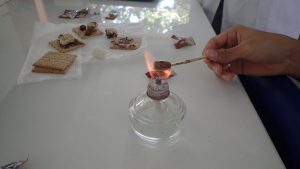
Step 4: Putting the marshmallows and the chocolate between the cracker
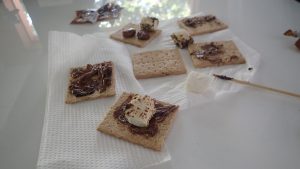
Step 5: The ACTUAL (experimental) mass of one s’mores: 28.5 grams

Step 6: Calculate the percent yield
Experimental Yield = 28.5 grams
Theoretical Yield = 30 grams
% yield = (Actual yield / Theoretical yield) * 100
28.5/30 = 0.95 * 100 = 95%
Percent yield = 95%
Step 7: EAT YOUR S’MORE!!! (:
Engineer Biography of Alexandre-Gustave Eiffel
Alexandre-Gustave Eiffel was the Architect and French engineer born on December 15, 1832, in Dijon and died at age 91 years old on December 28, 1923, in Paris. His parent was Catherine Melanie Moineuse and François Alexandre Boenickhausen. He famous for Architect, Civil Engineer, He also a founder/ Co-Founder: Eiffel & Cie.
Childhood & Early Life
The family came from a region near the Eifel mountains and adopted the name “Eiffel”. He spent most of his childhood with his grandmother. He studied at the ‘Lycee Royal’ in Dijon and earned his baccalaureate in science and humanities. He also had friend and uncle to teach Gustave philosophy, theology, chemistry, and mining.
To prepare himself for the difference entrance exams of engineering colleges he joined the College Sainte-Barbe in Paris. In 1855 he completed his graduation earning the thirteenth position out of eighty candidates.
Career
After completing his graduation he did an unpaid job for a few months to assist his brother-in-law in a foundry. He got his first paid job as the secretary  of Charles Nepveu, a railway engineer. When the company of Nepveu became bankrupt, he arranged for a bridge design work for Eiffel that was to be constructed for the ‘Saint Germaine’ railway. His reputation as an architect and civil engineer got him more projects and he established his own workshop in 1866 and undertook projects in different countries. One such project was an all-metal construction of the church of San Marcos in Arica, Chil
of Charles Nepveu, a railway engineer. When the company of Nepveu became bankrupt, he arranged for a bridge design work for Eiffel that was to be constructed for the ‘Saint Germaine’ railway. His reputation as an architect and civil engineer got him more projects and he established his own workshop in 1866 and undertook projects in different countries. One such project was an all-metal construction of the church of San Marcos in Arica, Chil
Various parts of the project were manufactured in France and shipped to the site to be assembled there. His technical innovations were path-breaking (specially prefabrication of cantilever constructions).
His most noted masterpiece that bears his name and went on to become one of his prominent works is the ‘Eiffel Tower’. Eiffel is most famous for what would become known as the Eiffel Tower, which was begun in 1887 for the 1889 Universal Exposition in Paris. The tower is composed of 12000 different components and 2500000, all designed and assembled to handle wind pressure. If it were melted down, the tower’s metal would only fill up its base about two and a half inches deep.
The Eiffel could build the world’s tallest structure(at 984 feet) in just two years and torn by the tower’s unique design, most deriding it as hideously modern and useless. The tower also directed Eiffel’s interest in the field of aerodynamics.
Eiffel turned his interest to meteorology in his final years, studying the subject at length before his death on December 28, 1923
Awards & Achievements
Thought out Eiffel career he designed and constructed a number of great structures, in one of the structures was the most famous and iconic structures is the world-famous Eiffel Tower. Also in 1912, the ‘Smithsonian Institution’ honored him with the ‘Samuel P.Langley Medal for Prodromic’ award.







Personal Life & Legacy
On July 8th, 1862 he got married to Marie Gaudelet. They remained married for fifteen years and had five children together (three girls, and two boys) before Marie caught pneumonia and died in 1887. Gustave never married any woman again. On the day Gustave dies, on December 28, 1923, while in his mansion on ‘Rue Rabelais’ in Paris and was buried in ‘ Levallois-Perret Cemetery’ in the family tomb.
3 defining principles/characteristics/values
Some characteristics that he had that make his goal success, are have, He becomes a high earning graduate students so people truth him and give him chance. He also determines to study day in and day out until he great at it. He is an intelligence how he works and how his think, He also put his full effort into every project that he had been working on. “In 1855 he completed his graduation earning the thirteenth position out of eighty candidates.” He many interests in the variety of subject. In his early life, he takes many interests like philosophy, theology, chemistry, and mining, even before his death that other subject with him. This makes him become a success people by having more knowledge so he can do anything he wants by using the skill that he had After the Eiffel Tower was built he had changed his interest in meteorology in his final years, studying the subject at length before his death on December 28, 1923. In his life, he had married with a woman and stay loyal to her all the time. So that makes people truth him and had him rise about everyone else. Other may think he loyal to his hard work with his job. He loyal because they saw the project like his life, If he to do it he will give it everything to finishing it with loyalty.
Works Cited
“Alexandre Gustave Eiffel.” American Society of Civil Engineers (ASCE), www.asce.org/templates/person-bio-detail.aspx?id=11166.
“Alexandre Gustave Eiffel Facts.” YourDictionary, biography.yourdictionary.com/alexandre-gustave-eiffel.
“Gustave Eiffel.” Wikipedia, Wikimedia Foundation, 11 Sept. 2018, en.wikipedia.org/wiki/Gustave_Eiffel.
TheBiography.us. “Biography of Alexandre-Gustave Eiffel <Small>(1832-1923)</Small>.” TheBiography.us, thebiography.us/en/eiffel-alexandre-gustave.
“Who Is Gustave Eiffel? Everything You Need to Know.” Childhood, Life Achievements & Timeline, www.thefamouspeople.com/profiles/gustave-eiffel-6809.php.
Flame Change Color When Have Contract With Chemical!
When an element get heated with the flame, heat will excite the electrons in the atom. This allows the electron to travel from the ground states to a higher energy level. So the atom becomes unstable and it will release energy to move into it ground stand back. In this releasing energy will match wavelength that it will energy emit and it also corresponds to the color of the visible light in a form of electromagnetic radiation.
I had an explanation about the concept of the idea with word now how can we see it with our eye, so we need to conduct an experiment that called the flame test lab in our chemistry class.

In the experiment, we had six different compounds of salt (Copper, Strontium, Barium, Lithium, Calcium, and Potassium). Each of them was placed on a popsicle stick that will be heated on the flame of a burner. All of the salt compounds emitted different colors and then we find the wavelength that corresponds to the color of the salt compound that was identifies.
Nevertheless, in an experiment, they would not be conducted with a perfect resolve. One possible source of error can be how we observed the color. Color is really tough to identify with our eye. This would lead us to an inaccurate of the color, that would affect the wavelengths we would find at the end. In the next experiment, I would avoid this error by using colorimeter can be used to accurately measure the wavelength.
The Rent Collector Poetry
Forever Give
This poem was inspired by the trash dump at Stung Meanchey. I wrote the poem from a perspective of a trash.
If I could be a tree …
I would turn myself big and cover you up
I would turn my leaves into cash and chase you toward the ending sky
they would run about your head and drop in piles at your feet…
so you would understand wonder.
If I could be a mountain …
I would kneel down and lift you up
I would turn my ground into a house so you can see all the wonderful places
so you would understand freedom.
If I could be an ocean …
I would transfer you across the great seas with my heart waves
You would swim with the dolphins and turtles in the growing waters,
So you would understand hope.
If I could be the sun …
I would warm you up
After the orange light turn out before the dark light turn in
I would gaze to the sky
show you the wonder, freedom, hope that it provided.
But who I am is who I am …
I am trash…
Love you until the end
Until the place close down…
Until the mountain kneels down and lift you up ….
Until the ocean transfer you across the great seas ….
Until orange light burns out ….
That how much I love you !!!
Forever and never want anything in return!!!!
SAT Preparation
On the first two weeks of the school year, we did PSAT Bootcamp. We had Amanda and Kim to be our mentors. For the two weeks we work with Kim and Amanda, they taught us many skill and strategy about SAT. I found the Reading and Language section was the hardest subject that blocking me from getting a high score when they took the test for the second English learner.

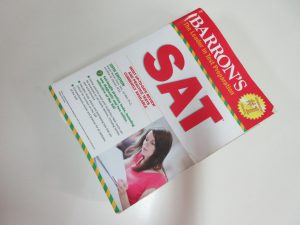
We took three PSAT over two weeks of practice with a website called Khan Academy, I can see really clear the improvement that I made when working with Kim and Amanda beside learning by myself. Also, I use the strategies that I learn with them to improve my score. After the first two weeks of the school year, in math class, we are still practicing for PSAT, by that we have independent time to work on some small subject like complex number and circle theorem. So that we can extend to a rage of math knowledge beside learning about the strategies.


